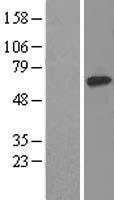KPNA2 (NM_002266) Human Tagged ORF Clone
CAT#: RC208803
KPNA2 (Myc-DDK-tagged)-Human karyopherin alpha 2 (RAG cohort 1, importin alpha 1) (KPNA2)
ORF Plasmid: tGFP
"NM_002266" in other vectors (6)
Need custom modification / cloning service?
Get a free quote
CNY 3,936.00
CNY 3,990.00
CNY 300.00
Specifications
| Product Data | |
| Type | Human Tagged ORF Clone |
| Tag | Myc-DDK |
| Synonyms | IPOA1; QIP2; RCH1; SRP1-alpha; SRP1alpha |
| Vector | pCMV6-Entry |
| E. coli Selection | Kanamycin (25 ug/mL) |
| Mammalian Cell Selection | Neomycin |
| Sequence Data |
>RC208803 ORF sequence
Red=Cloning site Blue=ORF Green=Tags(s) TTTTGTAATACGACTCACTATAGGGCGGCCGGGAATTCGTCGACTGGATCCGGTACCGAGGAGATCTGCC GCCGCGATCGCC ATGTCCACCAACGAGAATGCTAATACACCAGCTGCCCGTCTTCACAGATTCAAGAACAAGGGAAAAGACA GTACAGAAATGAGGCGTCGCAGAATAGAGGTCAATGTGGAGCTGAGGAAAGCTAAGAAGGATGACCAGAT GCTGAAGAGGAGAAATGTAAGCTCATTTCCTGATGATGCTACTTCTCCGCTGCAGGAAAACCGCAACAAC CAGGGCACTGTAAATTGGTCTGTTGATGACATTGTCAAAGGCATAAATAGCAGCAATGTGGAAAATCAGC TCCAAGCTACTCAAGCTGCCAGGAAACTACTTTCCAGAGAAAAACAGCCCCCCATAGACAACATAATCCG GGCTGGTTTGATTCCGAAATTTGTGTCCTTCTTGGGCAGAACTGATTGTAGTCCCATTCAGTTTGAATCT GCTTGGGCACTCACTAACATTGCTTCTGGGACATCAGAACAAACCAAGGCTGTGGTAGATGGAGGTGCCA TCCCAGCATTCATTTCTCTGTTGGCATCTCCCCATGCTCACATCAGTGAACAAGCTGTCTGGGCTCTAGG AAACATTGCAGGTGATGGCTCAGTGTTCCGAGACTTGGTTATTAAGTACGGTGCAGTTGACCCACTGTTG GCTCTCCTTGCAGTTCCTGAGATGTCATCTTTAGCATGTGGCTACTTACGTAATCTTACCTGGACACTTT CTAATCTTTGCCGCAACAAGAATCCTGCACCCCCGATAGATGCTGTTGAGCAGATTCTTCCTACCTTAGT TCGGCTCCTGCATCATGATGATCCAGAAGTGTTAGCAGATACCTGCTGGGCTATTTCCTACCTTACTGAT GGTCCAAATGAACGAATTGGCATGGTGGTGAAAACAGGAGTTGTGCCCCAACTTGTGAAGCTTCTAGGAG CTTCTGAATTGCCAATTGTGACTCCTGCCCTAAGAGCCATAGGGAATATTGTCACTGGTACAGATGAACA GACTCAGGTTGTGATTGATGCAGGAGCACTCGCCGTCTTTCCCAGCCTGCTCACCAACCCCAAAACTAAC ATTCAGAAGGAAGCTACGTGGACAATGTCAAACATCACAGCCGGCCGCCAGGACCAGATACAGCAAGTTG TGAATCATGGATTAGTCCCATTCCTTGTCAGTGTTCTCTCTAAGGCAGATTTTAAGACACAAAAGGAAGC TGTGTGGGCCGTGACCAACTATACCAGTGGTGGAACAGTTGAACAGATTGTGTACCTTGTTCACTGTGGC ATAATAGAACCGTTGATGAACCTCTTAACTGCAAAAGATACCAAGATTATTCTGGTTATCCTGGATGCCA TTTCAAATATCTTTCAGGCTGCTGAGAAACTAGGTGAAACTGAGAAACTTAGTATAATGATTGAAGAATG TGGAGGCTTAGACAAAATTGAAGCTCTACAAAACCATGAAAATGAGTCTGTGTATAAGGCTTCGTTAAGC TTAATTGAGAAGTATTTCTCTGTAGAGGAAGAGGAAGATCAAAACGTTGTACCAGAAACTACCTCTGAAG GCTACACTTTCCAAGTTCAGGATGGGGCTCCTGGGACCTTTAACTTT ACGCGTACGCGGCCGCTCGAGCAGAAACTCATCTCAGAAGAGGATCTGGCAGCAAATGATATCCTGGATT ACAAGGATGACGACGATAAGGTTTAA >RC208803 protein sequence
Red=Cloning site Green=Tags(s) MSTNENANTPAARLHRFKNKGKDSTEMRRRRIEVNVELRKAKKDDQMLKRRNVSSFPDDATSPLQENRNN QGTVNWSVDDIVKGINSSNVENQLQATQAARKLLSREKQPPIDNIIRAGLIPKFVSFLGRTDCSPIQFES AWALTNIASGTSEQTKAVVDGGAIPAFISLLASPHAHISEQAVWALGNIAGDGSVFRDLVIKYGAVDPLL ALLAVPEMSSLACGYLRNLTWTLSNLCRNKNPAPPIDAVEQILPTLVRLLHHDDPEVLADTCWAISYLTD GPNERIGMVVKTGVVPQLVKLLGASELPIVTPALRAIGNIVTGTDEQTQVVIDAGALAVFPSLLTNPKTN IQKEATWTMSNITAGRQDQIQQVVNHGLVPFLVSVLSKADFKTQKEAVWAVTNYTSGGTVEQIVYLVHCG IIEPLMNLLTAKDTKIILVILDAISNIFQAAEKLGETEKLSIMIEECGGLDKIEALQNHENESVYKASLS LIEKYFSVEEEEDQNVVPETTSEGYTFQVQDGAPGTFNF TRTRPLEQKLISEEDLAANDILDYKDDDDKV |
| Chromatograms |
CHROMATOGRAMS
 Sequencher program is needed, download here. |
| Restriction Sites |
SgfI-MluI
Cloning Scheme for this gene
Plasmid Map

|
| ACCN | NM_002266 |
| ORF Size | 1587 bp |
| OTI Disclaimer | The molecular sequence of this clone aligns with the gene accession number as a point of reference only. However, individual transcript sequences of the same gene can differ through naturally occurring variations (e.g. polymorphisms), each with its own valid existence. This clone is substantially in agreement with the reference, but a complete review of all prevailing variants is recommended prior to use. More info |
| OTI Annotation | This clone was engineered to express the complete ORF with an expression tag. Expression varies depending on the nature of the gene. |
| Product Components | The ORF clone is ion-exchange column purified and shipped in a 2D barcoded Matrix tube containing 10ug of transfection-ready, dried plasmid DNA (reconstitute with 100 ul of water). |
| Reconstitution | 1. Centrifuge at 5,000xg for 5min. 2. Carefully open the tube and add 100ul of sterile water to dissolve the DNA. 3. Close the tube and incubate for 10 minutes at room temperature. 4. Briefly vortex the tube and then do a quick spin (less than 5000xg) to concentrate the liquid at the bottom. 5. Store the suspended plasmid at -20°C. The DNA is stable for at least one year from date of shipping when stored at -20°C. |
| Note | Plasmids are not sterile. For experiments where strict sterility is required, filtration with 0.22um filter is required. |
| Reference Data | |
| RefSeq | NM_002266.4 |
| RefSeq Size | 2011 bp |
| RefSeq ORF | 1590 bp |
| Locus ID | 3838 |
| UniProt ID | P52292 |
| Domains | Armadillo_seg, IBB |
| Protein Families | Druggable Genome, Stem cell - Pluripotency |
| MW | 57.9 kDa |
| Gene Summary | The import of proteins into the nucleus is a process that involves at least 2 steps. The first is an energy-independent docking of the protein to the nuclear envelope and the second is an energy-dependent translocation through the nuclear pore complex. Imported proteins require a nuclear localization sequence (NLS) which generally consists of a short region of basic amino acids or 2 such regions spaced about 10 amino acids apart. Proteins involved in the first step of nuclear import have been identified in different systems. These include the Xenopus protein importin and its yeast homolog, SRP1 (a suppressor of certain temperature-sensitive mutations of RNA polymerase I in Saccharomyces cerevisiae), which bind to the NLS. KPNA2 protein interacts with the NLSs of DNA helicase Q1 and SV40 T antigen and may be involved in the nuclear transport of proteins. KPNA2 also may play a role in V(D)J recombination. Alternative splicing results in multiple transcript variants. [provided by RefSeq, Feb 2016] |
Documents
| Product Manuals |
| FAQs |
| SDS |
Resources
Other Versions
| SKU | Description | Size | Price |
|---|---|---|---|
| RC208803L1 | Lenti ORF clone of Human karyopherin alpha 2 (RAG cohort 1, importin alpha 1) (KPNA2), Myc-DDK-tagged |
CNY 6,336.00 |
|
| RC208803L2 | Lenti ORF clone of Human karyopherin alpha 2 (RAG cohort 1, importin alpha 1) (KPNA2), mGFP tagged |
CNY 5,890.00 |
|
| RC208803L3 | Lenti ORF clone of Human karyopherin alpha 2 (RAG cohort 1, importin alpha 1) (KPNA2), Myc-DDK-tagged |
CNY 6,336.00 |
|
| RC208803L4 | Lenti ORF clone of Human karyopherin alpha 2 (RAG cohort 1, importin alpha 1) (KPNA2), mGFP tagged |
CNY 5,890.00 |
|
| RG208803 | KPNA2 (tGFP-tagged) - Human karyopherin alpha 2 (RAG cohort 1, importin alpha 1) (KPNA2) |
CNY 5,536.00 |
|
| SC321886 | KPNA2 (untagged)-Human karyopherin alpha 2 (RAG cohort 1, importin alpha 1) (KPNA2) |
CNY 3,944.00 |


 United States
United States
 Germany
Germany
 Japan
Japan
 United Kingdom
United Kingdom
 China
China




